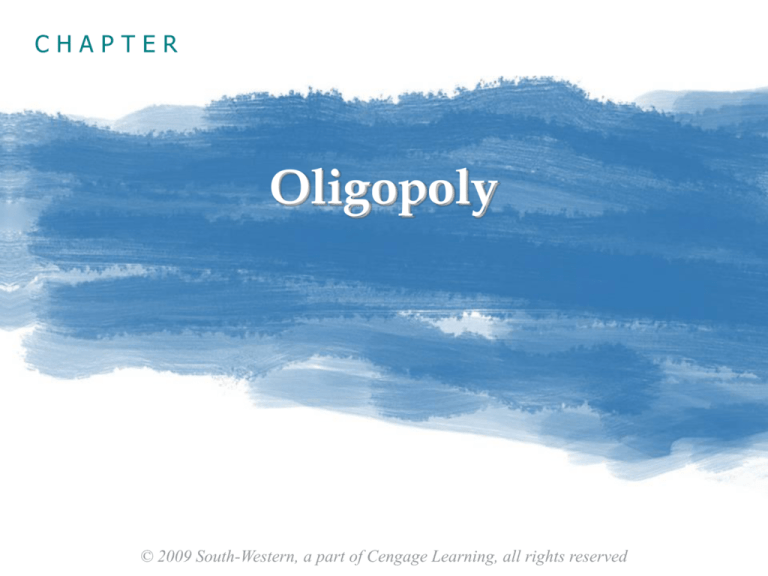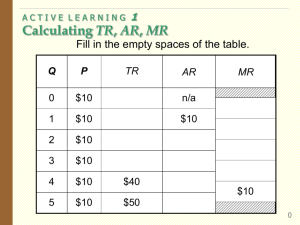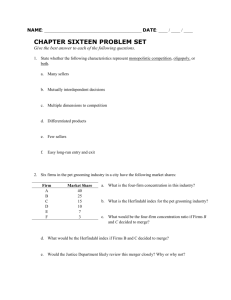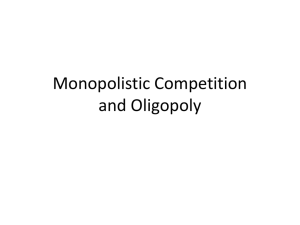
CHAPTER
Oligopoly
© 2009 South-Western, a part of Cengage Learning, all rights reserved
Measuring Market Concentration
Concentration ratio: the percentage of the
market’s total output supplied by its four largest
firms.
The higher the concentration ratio,
the less competition.
This chapter focuses on oligopoly,
a market structure with high concentration ratios.
OLIGOPOLY
1
Oligopoly
Oligopoly: a market structure in which only a
few sellers offer similar or identical products.
Strategic behavior in oligopoly:
A firm’s decisions about P or Q can affect other
firms and cause them to react. The firm will
consider these reactions when making decisions.
Game theory: the study of how people behave
in strategic situations.
OLIGOPOLY
2
EXAMPLE: Cell Phone Duopoly in Smalltown
Smalltown has 140 residents
P
Q
$0
140
5
130
10
120
15
110
20
100
25
90
30
80
(duopoly: an oligopoly with two firms)
35
70
Each firm’s costs: FC = $0, MC = $10
40
60
45
50
OLIGOPOLY
The “good”:
cell phone service with unlimited
anytime minutes and free phone
Smalltown’s demand schedule
Two firms: T-Mobile, Verizon
3
EXAMPLE: Cell Phone Duopoly in Smalltown
P
Q
$0
140
5
130
650
1,300
–650
10
120
1,200
1,200
0
15
110
1,650
1,100
550
20
100
2,000
1,000
1,000
25
90
2,250
900
1,350
30
80
2,400
800
1,600
35
70
2,450
700
1,750
40
60
2,400
600
1,800
45
50
2,250
500
1,750
OLIGOPOLY
Revenue
Cost
Profit
$0 $1,400 –1,400
Competitive
outcome:
P = MC = $10
Q = 120
Profit = $0
Monopoly
outcome:
P = $40
Q = 60
Profit = $1,800
4
EXAMPLE: Cell Phone Duopoly in Smalltown
One possible duopoly outcome: collusion
Collusion: an agreement among firms in a
market about quantities to produce or prices to
charge
T-Mobile and Verizon could agree to each produce
half of the monopoly output:
For each firm: Q = 30, P = $40, profits = $900
Cartel: a group of firms acting in unison,
e.g., T-Mobile and Verizon in the outcome with
collusion
OLIGOPOLY
5
ACTIVE LEARNING
1
Collusion vs. self-interest
P
Q
$0
140
5
130
10
120
15
110
20
100
25
90
30
80
35
70
40
60
45
50
Duopoly outcome with collusion:
Each firm agrees to produce Q = 30,
earns profit = $900.
If T-Mobile reneges on the agreement and
produces Q = 40, what happens to the
market price? T-Mobile’s profits?
Is it in T-Mobile’s interest to renege on the
agreement?
If both firms renege and produce Q = 40,
determine each firm’s profits.
6
ACTIVE LEARNING
Answers
P
Q
$0
140
5
130
10
120
15
110
20
100
25
90
30
80
35
70
40
60
45
50
1
If both firms stick to agreement,
each firm’s profit = $900
If T-Mobile reneges on agreement and
produces Q = 40:
Market quantity = 70, P = $35
T-Mobile’s profit = 40 x ($35 – 10) = $1000
T-Mobile’s profits are higher if it reneges.
Verizon will conclude the same, so
both firms renege, each produces Q = 40:
Market quantity = 80, P = $30
Each firm’s profit = 40 x ($30 – 10) = $800
7
Collusion vs. Self-Interest
Both firms would be better off if both stick to the
cartel agreement.
But each firm has incentive to renege on the
agreement.
Lesson:
It is difficult for oligopoly firms to form cartels and
honor their agreements.
OLIGOPOLY
8
ACTIVE LEARNING
2
The oligopoly equilibrium
P
Q
$0
140
5
130
10
120
15
110
20
100
25
90
30
80
35
70
40
60
45
50
If each firm produces Q = 40,
market quantity = 80
P = $30
each firm’s profit = $800
Is it in T-Mobile’s interest to increase its
output further, to Q = 50?
Is it in Verizon’s interest to increase its
output to Q = 50?
9
ACTIVE LEARNING
Answers
P
Q
$0
140
5
130
10
120
15
110
20
100
25
90
30
80
35
70
40
60
45
50
2
If each firm produces Q = 40,
then each firm’s profit = $800.
If T-Mobile increases output to Q = 50:
Market quantity = 90, P = $25
T-Mobile’s profit = 50 x ($25 – 10) = $750
T-Mobile’s profits are higher at Q = 40
than at Q = 50.
The same is true for Verizon.
10
The Equilibrium for an Oligopoly
Nash equilibrium: a situation in which
economic participants interacting with one another
each choose their best strategy given the strategies
that all the others have chosen
Our duopoly example has a Nash equilibrium
in which each firm produces Q = 40.
Given that Verizon produces Q = 40,
T-Mobile’s best move is to produce Q = 40.
Given that T-Mobile produces Q = 40,
Verizon’s best move is to produce Q = 40.
OLIGOPOLY
11
A Comparison of Market Outcomes
When firms in an oligopoly individually choose
production to maximize profit,
oligopoly Q is greater than monopoly Q
but smaller than competitive Q.
oligopoly P is greater than competitive P
but less than monopoly P.
OLIGOPOLY
12
The Output & Price Effects
Increasing output has two effects on a firm’s profits:
Output effect:
If P > MC, selling more output raises profits.
Price effect:
Raising production increases market quantity,
which reduces market price and reduces profit
on all units sold.
If output effect > price effect,
the firm increases production.
If price effect > output effect,
the firm reduces production.
OLIGOPOLY
13
The Size of the Oligopoly
As the number of firms in the market increases,
the price effect becomes smaller
the oligopoly looks more and more like a
competitive market
P approaches MC
the market quantity approaches the socially
efficient quantity
Another benefit of international trade:
Trade increases the number of firms competing,
increases Q, brings P closer to marginal cost
OLIGOPOLY
14
Game Theory
Game theory helps us understand oligopoly and
other situations where “players” interact and
behave strategically.
Dominant strategy: a strategy that is best
for a player in a game regardless of the
strategies chosen by the other players
Prisoners’ dilemma: a “game” between
two captured criminals that illustrates
why cooperation is difficult even when it is
mutually beneficial
OLIGOPOLY
15
Prisoners’ Dilemma Example
The police have caught Bonnie and Clyde,
two suspected bank robbers, but only have
enough evidence to imprison each for 1 year.
The police question each in separate rooms,
offer each the following deal:
If you confess and implicate your partner,
you go free.
If you do not confess but your partner implicates
you, you get 20 years in prison.
If you both confess, each gets 8 years in prison.
OLIGOPOLY
16
Prisoners’ Dilemma Example
Confessing is the dominant strategy for both players.
Nash equilibrium:
Bonnie’s decision
both confess
Confess
Confess
Clyde’s
decision
Bonnie gets
8 years
Clyde
gets 8 years
Bonnie goes
free
Remain
silent Clyde
gets 20 years
OLIGOPOLY
Remain silent
Bonnie gets
20 years
Clyde
goes free
Bonnie gets
1 year
Clyde
gets 1 year
17
Prisoners’ Dilemma Example
Outcome: Bonnie and Clyde both confess,
each gets 8 years in prison.
Both would have been better off if both remained
silent.
But even if Bonnie and Clyde had agreed before
being caught to remain silent, the logic of selfinterest takes over and leads them to confess.
OLIGOPOLY
18
Oligopolies as a Prisoners’ Dilemma
When oligopolies form a cartel in hopes
of reaching the monopoly outcome,
they become players in a prisoners’ dilemma.
Our earlier example:
T-Mobile and Verizon are duopolists in
Smalltown.
The cartel outcome maximizes profits:
Each firm agrees to serve Q = 30 customers.
Here is the “payoff matrix” for this example…
OLIGOPOLY
19
T-Mobile & Verizon in the Prisoners’ Dilemma
Each firm’s dominant strategy: renege on agreement,
produce Q = 40.
T-Mobile
Q = 30
Q = 30
Verizon
Q = 40
OLIGOPOLY
T-Mobile’s
profit = $900
Verizon’s
profit = $900
T-Mobile’s
profit = $750
Verizon’s profit
= $1000
Q = 40
T-Mobile’s
profit = $1000
Verizon’s
profit = $750
T-Mobile’s
profit = $800
Verizon’s
profit = $800
20
ACTIVE LEARNING
3
The “fare wars” game
The players: American Airlines and United Airlines
The choice: cut fares by 50% or leave fares alone
If both airlines cut fares,
each airline’s profit = $400 million
If neither airline cuts fares,
each airline’s profit = $600 million
If only one airline cuts its fares,
its profit = $800 million
the other airline’s profits = $200 million
Draw the payoff matrix, find the Nash equilibrium.
21
ACTIVE LEARNING
3
Answers
Nash equilibrium:
both firms cut fares
American Airlines
Cut fares
$400 million
Don’t cut fares
$200 million
Cut fares
United
Airlines
$400 million
$800 million
$800 million
$600 million
Don’t cut
fares
$200 million
$600 million
22








